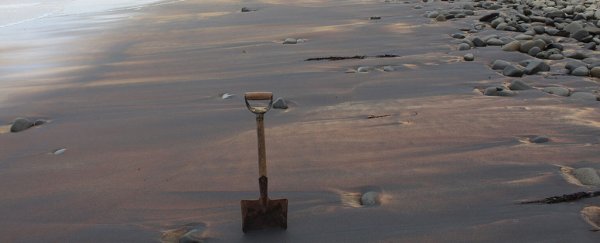Scientists can use various clues to figure out what's under Earth's surface without actually having to do any digging – including firing super-fine lasers thinner than a human hair at minerals found in beach sand.
This technique has been used in a new study that points to a 4-billion-year-old piece of Earth's crust about the size of Ireland, which has been sitting under Western Australia and influencing the geological evolution of the area across millions of millennia.
It might be able to provide clues to how our planet went from being uninhabitable to supporting life.
The researchers think that the huge expanse of crust would have heavily influenced the formation of rocks as old materials were mixed with new, having first appeared as one of the planet's earliest protocrust formations and surviving multiple mountain-building events.
"When comparing our findings to existing data, it appears many regions around the world experienced a similar timing of early crust formation and preservation," says geology PhD student and lead author Maximilian Dröellner, from Curtin University in Australia.
"This suggests a significant change in the evolution of Earth some 4 billion years ago, as meteorite bombardment waned, crust stabilized, and life on Earth began to establish."
The lasers were used to vaporize grains of the mineral zircon, taken from sand sampled from rivers and beaches in Western Australia.
Technically known as laser ablation split stream-inductively coupled plasma-mass spectrometry, the method enables scientists to date the grains and compare them with others to see where they might have come from.
This gave the team an insight into the crystalline basement under Earth's surface in this particular region – showing where the grains had originally eroded from, the forces used to create them, and how the geology of the region had built up over time.
As well as the significance of the protocrust remnant still being there – about 100,000 square kilometers (38,610 square miles) of it – the boundaries of the block will also help scientists to chart out what else is hidden away under Earth's surface, and how it might have evolved to be in its current state.
"The edge of the ancient piece of crust appears to define an important crustal boundary controlling where economically important minerals are found," says research supervisor geologist Milo Barham, from Curtin University.
"Recognizing these ancient crustal remnants is important for the future of optimized sustainable resource exploration."
As you might expect after 4 billion years, there's not much left of Earth's original crust to study, which makes findings like this one all the more interesting and useful to experts – giving us an important window into the distant past.
The shifting of Earth's crust and the swirling of the hot mantle underneath are difficult to predict and to retrospectively map out. When evidence of interior movement and geology can be found on the surface, scientists are therefore very keen to make use of it.
Further down the line, the results of the study described here could also help scientists who are looking at other planets – the way these planets are formed, how their earliest crust is shaped, and even how alien life might get established on them.
"Studying the early Earth is challenging given the enormity of time that has elapsed, but it has profound importance for understanding life's significance on Earth and our quest to find it on other planets," says Barham.
The research has been published in the journal Terra Nova.
